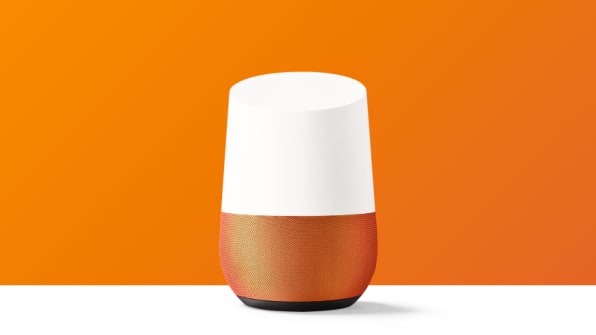Now That It Knows Who’s Talking, Google Home Might Reach Its Potential
Until recently, the Google Home connected speaker didn’t have much of a purpose in life.
While Home has been an effective showcase for Google’s voice recognition skills and its deep understanding (or occasional misunderstanding) of the web, it’s also been strangely disconnected from Google services. In lieu of deep ties to services like Gmail, Calendar, Keep, Allo, and Duo, the $ 130 speaker was little more than an Amazon Echo imitator.
That’s why support for multiple accounts and the ability to distinguish between speakers, which arrived last week, is a big deal. Now Google Home can make sure it’s talking to the right person before it grants access to personal information, making it more practical for families and roommates. Down the road, this should allow the speaker to tie into a greater range of Google services.
At the same time, that personalization will help fulfill Google’s underlying business goal of serving up targeted ads. Just as the Echo is, on some level, a path to to shopping more on Amazon, Home’s personalized interactions will allow Google to advertise more effectively.
To Each Their Own Assistant
The way Google Home handles personalization is pretty clever. Each account requires a separate iOS or Android device, each with a unique login for the Google Home companion app. If all you have is a single smartphone, there’s no way to add or manage multiple accounts.
While this approach may sound restrictive, it allows for maximum personalization with minimal effort. Once users have trained Google’s neural network to recognize their voices—a breezy process that involves saying “Okay Google” and “Hey Google” into the smartphone app twice apiece—Google Home can immediately offer individual calendar agendas, Google Play Music playlists, shopping lists, and photos (which can be beamed to a nearby Chromecast).
Users can also dive into the Google Home app to customize further. Each user, for instance, can choose different preferred news sources for a daily briefing, select from multiple work locations for commute information, and connect to third-party services using their own individual accounts. After connecting with Todoist, for instance, Google Home offered access to separate task lists based on who was talking.
Still, Google Home remains limited in the number of Google services to which it can connect. You can’t, for instance, send emails, take notes, schedule appointments, place calls, and exchange text messages through the speaker, even though Google’s Assistant on Android phones allows you to do all those things. (One notable exception: You can now shop by voice through Google Express, with voice recognition eliminating the need for a security code.)
Perhaps Google is holding off on more capabilities as it refines its voice recognition, which in my experience hasn’t been flawless. On a couple occasions, Google didn’t recognize my wife’s voice when she asked for personal information, and suggested either trying again or retraining the voice model. But I also got Google to give up my personal information on one occasion while speaking in an intentionally silly and high-pitched voice. So either Google is frighteningly good at recognizing me at any pitch—unlikely, given that it rejected my request in an exaggerated deep voice—or the system isn’t foolproof.
Getting a connected speaker to recognize different voices from across the room is a tough technical challenge, because the same signal processing that eliminates background noise and reverb can also wipe away a voice’s defining characteristics. With voice shopping, you still get email confirmation and can cancel erroneous orders before they’ve shipped. But Google might not want to open up more potentially sensitive functions for its connected speaker until these glitches are worked out.

Getting To Know You
Google has plenty of motivation to improve its voice recognition and open up Google Home to more services as the company looks to monetize those interactions through targeted ads.
This goal is not a secret. On Google’s privacy FAQ page, for instance, the company notes that it treats voice commands similarly to searches on Google. That means the company can use Google Home interactions to deliver more personalized ads on other devices.
In the future, Google could also use those interactions for advertising on Google Home itself. When asked last year by Forbes how Google might monetize its connected speaker and virtual assistant, CEO Sundar Pichai hinted at the possibility of sponsored results.
“Inherently, when information needs are commercial, you are connecting users with people who provide services. I think there are natural opportunities,” Pichai said.
With voice recognition, it’s easy to see how this might play out: If a user asks Google Home to order some food, it can look up the kinds of restaurants that user has searched for or visited in the past, and offer a suggestion from whatever company pays for top placement. Or when a user asks for his or her daily briefing, Google could insert a promotion based on what it knows from that user’s search history.
There’s nothing inherently wrong with an ad-supported business model, but it can be challenging to pull off without seeming overly intrusive or obnoxious. Last month’s snafu in which some Google Home users were treated to a lengthy Beauty and the Beast promo during their daily briefings was an example of the company missing the mark. Now that Google understands who’s talking, it can try to do a better job.
(33)



